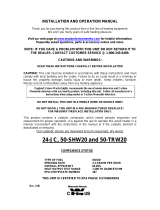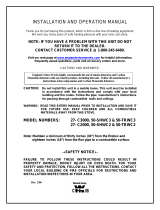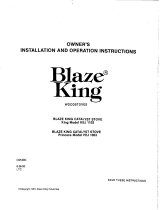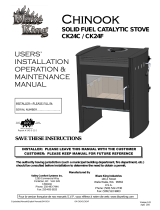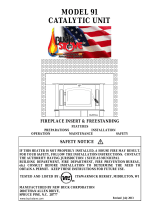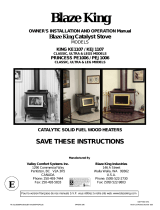Page is loading ...

INSTALLATION & OPERATION MANUAL
Thank you for purchasing this product from a fine line of heating equipment.
We wish you many years of safe heating pleasure.
Visit our web site at www.englandsstoveworks.com for helpful information,
frequently asked questions, parts & accessory orders and more.
NOTE: IF YOU HAVE A PROBLEM WITH THIS UNIT DO NOT RETURN IT TO THE
DEALER. CONTACT CUSTOMER SERVICE @ 1-800-245-6489.
Please note the following Precautionary Statements:
CAUTION: This unit must be installed in accordance with these instructions and
must comply with local building and fire codes. Failure to do so could result in a
chimney or house fire, property damage, bodily injury or even death.
Keep children, furniture, fixtures and all combustibles away from any heating appliance.
Maintain a minimum clearance of thirty inches (30”) from the firebox and eighteen inches
(18”) from the flue pipe to any combustible. This can be reduced to six inches (6”) by
using a heat shield and double wall or shielded pipe.
This product contains a catalytic combustor, which needs periodic inspection and
replacement for proper operation. It is against the law to operate this wood heater with
the catalytic combustor removed, deactivated or in a manner inconsistent with the
operating instruction in this manual.
Our catalytic stoves are designed to burn seasoned, dry wood.
THIS STOVE IS NOT MOBILE HOME APPROVED.
DO NOT PLACE IN A MOBILE HOME!
24-ICD, 50-SHW25 and 50-TRW25
COMPLIANCE STATUS
Type of Fuel Wood
Emission Rate 2.4 Grams/Hour
Tested Overall Efficiency 83.78%
EPA Certificate Number 443
This unit is certified to EPA phase II standards.
Revised 11/07
England’s Stove Works highly recommends the use of smoke detectors and Carbon
Monoxide detectors with any hearth product, including this unit. Follow all manufacturer’s
instructions when using smoke or Carbon Monoxide detectors.

SAFETY NOTICE:
IF THIS UNIT IS NOT PROPERLY INSTALLED, A HOUSE FIRE MAY
RESULT. FOR YOUR SAFETY, FOLLOW THE INSTALLATION DIRECTIONS.
CONTACT LOCAL BUILDING OR FIRE OFFICIALS CONCERNING
RESTRICTIONS AND INSTALLATION INSPECTIONS IN YOUR AREA.
SECTION I: FLUE SYSTEM
CAUTION: Follow the pipe manufacturer’s installation instructions and directions
for passing through combustible walls and ceilings. Check local codes in your
area.
A. Existing Flue System
This is a freestanding unit and is designed to connect to an existing flue system, such
as masonry or a pre-manufactured Class A flue system. If you have a masonry system,
the inner liner should be inspected very carefully for cracks; if there is no liner in your
chimney, we recommend you install one or have a stainless steel liner installed. If you
have an existing stainless steel liner it should be inspected to ensure there is no
buckling, warping or cracks in the system.
Either type chimney should be thoroughly cleaned before installing the new unit. We
strongly recommend that you have a qualified chimney sweep do the inspection and
cleaning. The sweep can spot problems that you might overlook, and at the same time
advise of any required changes. In most cases the sweep can make any necessary
changes or at least recommend qualified people to do so. Note: It is not permissible to
connect this unit to a chimney that serves another unit.
B. Flue Size
The proper flue size is determined by the inside diameter of the flue collar on the unit.
This unit comes with a six inch (6”) Top or Rear exhaust flue collar. The connector pipe
should be at least six inches (6”) or larger and never smaller than the collar; the area of
the chimney must also be equal to or greater than the area of the flue collar. If the area
of the flue is greater than the area of the collar, it should not be more than three (3)
times greater.
Example: The area of a six inch (6”) flue collar is 28.87 square inches, therefore the
area of the connector pipe should be at least 28.87 square inches and never more than
84.8 square inches.
C. Top or Rear Exhaust
This stove comes with an adaptable top or rear exhaust system. The unit is packaged at
the plant with the top exhaust system but can be changed by switching the parts; if you
switch to a rear exhaust be sure the gaskets are in place and all the bolts are tight. The
connector pipe should be 24-gauge steel pipe and inserted (crimped end) into the flue
collar. This will reverse the pipe and keep any creosote inside the connector pipe.
*IMPROPER INSTALLATION: The manufacturer will not be held responsible for damage
caused by the malfunction of a stove due to improper venting or installation. Call
(
800-245-6489
)
and/or consult a
p
rofessional installer if
y
ou have an
y
q
uestions.

Note on Outside Air Hookup: You can use an outside air hookup with our catalytic stoves. We highly recommend it for
homes built since the more air-tight construction standards went into effect. This involves connecting a metal pipe
(usually three inches (3”) in diameter - check your stove - and the pipe can be flex or rigid) from the air inlet pipe located
on the bottom rear of the stove through your floor or wall. The outside end of this pipe should be covered in some manner
to keep it clear of foreign matter.

D. Installation of a New Flue System
1. Masonry Flue:
Most masonry flue systems are on the outside wall of the house and extend upward
against the outside wall. The flue thimble is on the inside wall and makes the connection
with the vertical flue and your stove flue pipe. You must maintain the proper clearance
between the connecting flue pipe and any combustibles; if your chimney has a clean-out
door, it is necessary this door be airtight. All the combustion air should be pulled through
the stove and not through the clean-out, pipe seams or any other place.
If you are planning to build a masonry flue system, we highly recommend you hire a
professional, as he will be more familiar with local building and fire codes. It is your
responsibility to ensure the chimney or flue system is in safe operating condition. The
manufacturer will not be responsible for an accident attributed to a faulty chimney.
2. Pre-Manufactured Flue System:
This type system has become very popular because it is very easy to install and is
very safe when installed correctly. In making your choice be sure the system has a
recognized label of approval such as U.L., B.O.C.A. or I.C.B.O. -- any of these approvals
will assure the flue system is constructed of the proper materials and meets the required
safety standards. Your local dealer will normally handle a top grade approved flue pipe.
There are two very popular methods of installing a pre-manufactured flue system.
The first and least expensive is through the ceiling and out the roof -- this is the most
direct route, requires fewer pipes and creates a better draw. It is less expensive
not only because less pipe is required, but also because double wall pipe is only
required from the ceiling through the roof. Single wall 24 gauge pipe is used from the
stove up to the ceiling. The second method is to go through the wall and up the outside
of the house. This method is more expensive, because it requires insulated pipe through
the wall and up the outside of the house; in either type of installation you should be
careful, as proper clearances to combustibles are very important. You can consult with
your local dealer for information on a qualified contractor or installer. It your responsibility
to ensure the flue system is safe and in good operating condition. The manufacturer will
not be responsible for an accident attributed to a unit connected to a faulty flue system.
SECTION II: FLOOR AND WALL PROTECTION
A. Floor Protection
You will not need any floor protection if your floor is constructed of a non-combustible
material such as brick or concrete. If your floor is made of a combustible material such
as hardwood, carpet or linoleum, you must have protection between the stove and the
floor. Any stove board that is purchased should be U.L. listed and rated. This stove will
require a minimum board size of 36” x 48” for the floor. The approved protector should
be large enough to provide eight inches (8”) behind the unit, eight inches (8”) on each
side and sixteen inches (16”) in the front of the stove.
Note: Flue systems and flue pipe are not furnished with the unit. They must be
purchased separately.

B. Wall Protection
This stove’s normal clearance to a combustible such as paneling, wallpaper or
drywall is thirty inches (30”). You should check local codes for clearances to
combustibles, as some areas require more than thirty inches (30”). If you need to place
your unit closer than the required minimum, a wall board or heat shield can be used.
Installing a wall board with a one inch (1”) air space (between the wall and the board) will
reduce your clearance by 2/3 or to twelve inches (12”). The wallboard must be only six
inches (6”) higher than the top of the unit. In moving the unit closer to the wall, the
connector pipe may be closer than eighteen inches (18”) and in this case shielded or
double wall pipe will have to be used. This will allow your pipe to be six inches (6”) from
a combustible.
C. Heat Shield
The AC-IHS (SH-HS25) Side and Rear Heat Shield is a two-piece shield that
attaches to the rear of the unit. When attached to the stove it covers the back of the unit
and approximately twelve inches (12”) on each side. This allows six inches (6”)
clearance from the rear; however, thirty inches (30”) will be required in the area the
shield does not cover. When using the heat shield you will be required to use shielded or
double wall pipe, as it will be less than eighteen inches (18”) from the wall.
(NOTE: You must use the top vent option of your unit with the use of this heat shield.)
SECTION III: PLACEMENT AND INSTALLATION
All of our units are well constructed and very heavy, so you must take caution getting
the stove into your home. You can remove the door and the firebrick to make the unit
lighter, but make a note of the brick layout before removing them. Never try handling this
product alone!!! We recommend using a handcart on any heating appliance.
Chimney Connector Pipe
The 24-gauge black steel connector pipe for this unit must be six inches (6”) in
diameter. Do not use pipe that is galvanized or aluminum, as it will not withstand the
extreme temperatures of a wood fire, and do not use chimney connector pipe (single
wall) as a chimney. In this application, triple wall or packed pipe is required. The
connector pipe should have the crimped end inserted into the flue collar, which will
reverse the rest of the pipe. This will allow any creosote that is formed in the pipe to stay
inside the pipe and stove.
For proper operation, the chimney pipe should be as short as possible and have an
upward slope of one-fourth inch (1/4”) per foot to the thimble. It is required that you keep
an eighteen-inch (18”) clearance from your pipe to combustible surfaces such as the wall
or ceiling. If your installation is less, it will require the use of double wall or shielded pipe.
IMPORTANT SAFETY NOTE: If the unit or chimney connector pipe “glows” red (or
white), the stove is over-fired. This condition could cause a house or chimney fire.
Do not operate your unit too hot, or over-firing may result (see “Operating
Instructions” section of manual).

SECTION IV: ACCESSORY ITEMS
AC-101/SH-101 Brass Trim
There are three (3) pieces of J-channel trim in this kit that snap onto the two top
edges of the unit and the ash apron edge. Remove the protective cover from the trim
and match it to the corresponding edge of the stove -- the trim simply slips over the
corresponding edge of the unit. If required, high temperature silicone can be used on the
inside of the trim.
AC-01 Brass Knobs (Per Set)
The brass knobs have a wide base and sit on the top of the stove.
AC-02 Brass Rail
This accessory is pre-mounted on a metal base and sits on the top of the stove.
AC-IHS/SH-HS25 Side and Rear Heat Shield
This accessory is a two piece heat shield that is installed to the rear of the stove and
will give six inches (6”) clearance to a combustible. The shield is attached one piece at a
time, with the bolts mounting to the four weld nuts on the rear of the stove. This heat
shield will allow six inches (6”) clearance from the rear of the unit; however, the thirty
inches (30”) clearance to a combustible will still be required on the sides. The flue pipe
must be shielded or double wall if it is less than eighteen inches (18”) from a
combustible.
NOTE: You must use the top vent option of your unit with the use of this heat shield.
SECTION V: OPERATING INSTRUCTIONS
A. Building a Fire
Your new stove is equipped with a catalytic combustor, which requires the following
start-up procedure. Inspect your unit to ensure the combustor is well seated in the
combustor housing.
CAUTION: ALWAYS PULL OUT THE BY-PASS DAMPER COMPLETELY BEFORE
OPENING THE FRONT DOOR. NEVER LIGHT YOUR FIRE WITH GASOLINE,
KEROSENE, DIESEL FUEL OR CHARCOAL LIGHTER FLUID; THIS COULD BE
VERY DANGEROUS.
NOTICE: Your new stove and the connector pipe may smoke for a short period of time.
This is called “cooking out” and is no cause for alarm. During the first few hours
of operation, it is a good idea to open some doors and windows.
1. Be sure there are no combustible materials in the immediate area of the stove.
2. Pull out the slide damper located under the ash lip and the by-pass damper located
on the top right side of the unit.

3. Place several wads of crushed newspaper over the entire bottom of the firebox.
4. Lay small dry sticks of kindling on top of the paper.
5. Ignite the paper. Leave the door cracked until the kindling is burning freely --
approximately ten to fifteen (10 to 15) minutes.
6. Once you have established a hot bed of coals, open the door and add a few pieces
of dry split wood. Leave the door cracked and allow the unit to burn for approximately
thirty (30) minutes. After this time, more split wood can be added.
7. The final step is to close the by-pass damper and place the slide damper (located
under the ash apron) to your desired setting. Note: Pulling the slide damper out will
increase the amount of combustion air and allow a faster burn.
NOTE: It is very important the above procedure be followed to ensure the catalytic
combustor reaches the proper temperature. It is recommended the combustor be
operated at 700 to 1400 degrees Fahrenheit; the combustor must be 500 degrees
Fahrenheit or above before it will accept the smoke fumes. Operating the unit above
1800 degrees will damage the combustor, although temperatures between 1400 and
1600 degrees are common. If minor-build up is evident on the combustor, run the unit at
a high rate and leave the by-pass damper partially open to help clean the combustor. A
one fourth inch (¼”) button plug is located on the top left side of the stove. This plug can
be removed and a Condor probe thermometer (Part #AC-13) inserted, which will display
the actual temperature of the combustor. This part can be ordered by your local dealer
or from the factory.
B. Draft Control
This unit has a slide draft control located under the ash apron, which is used to
regulate the amount of combustion air. This controls the amount of heat the stove
produces, as well as the burn time. The more you open the draft by pulling out the
handle, the more combustion air enters the firebox; this will cause the stove to burn
hotter and faster. You will have to experiment with your unit for the most efficient setting,
as no two chimneys are the same. If you have problems regulating the unit please call
your dealer or the factory.
C. Do Not Over-Fire Your Stove
Burning flammable liquids, too much wood and trash in the stove can result in over-
firing. If the chimney pipe turns red or even worse, white, the unit has been over-fired.
This may ignite creosote in the chimney and possibly cause a house fire. If this does
happen, immediately close the slide damper by pushing it in completely and close the
by-pass damper. Get out of the house and call the fire department. A chimney fire may
cause structural damage to the chimney system, therefore do not use the stove until the
entire flue system is inspected and, if necessary, repaired or replaced. A chimney sweep
can perform this inspection.
D. Everyday Fueling
This unit is designed to burn eight to ten (8 to 10) hours on one load of firewood.
Always open or pull out the by-pass damper before opening the stove door. The door
should be cracked for five to ten (5 to 10) minutes to allow the excess smoke to clear
through your flue system.

Once you have opened the door properly, you should have a bed of hot coals in the
bottom of the firebox. With the use of a poker, pull the bed of hot ashes towards the front
door of the unit, then fill the stove with seasoned wood and burn the unit for
approximately thirty (30) minutes with the door cracked. The next step is to close the
door and the by-pass damper and set the front slide damper to your desired burn. Follow
this procedure each time you fuel your stove.
E. Ash Removal and Disposal
Regularly inspect the ash build-up in your stove and remove as necessary. Ashes
should be placed in a metal container with an airtight lid. Pending disposal, they should
be placed on a non-combustible surface completely away from any combustible
material. The ashes should be retained in the closed container until all cinders have
thoroughly cooled. Note: It is essential that your flue system be checked for creosote
build-up at least twice per month.
SECTION VI: CARE AND MAINTENANCE
A. Catalytic Combustor Maintenance
Note – Your unit will have a 3” thick, 25-cell combustor (manufactured by Applied Ceramics), or it
will have a 1” thick, “ceramic foam” type combustor (manufactured by Clear Skies). The following
instructions apply to both types, unless otherwise specified.
1. To reach the combustor, first take out the Flame Impingement Plate by removing the
four (4) 3/8” brass nuts (they take a 9/16” wrench). Once the nuts are removed the
plate should drop from the four bolts. This will allow you to see the bottom of your
catalytic combustor.
2. For 25-cell Applied Ceramics combustor: If the combustor is plugged up you will see
black soot within the cells on the bottom side of the ceramic piece. This can usually
be removed by brushing the combustor with a soft bristled brush. You can also run a
pipe stem cleaner through each cell for removal of any internal build-up. This type of
cleaning can be done without removing the combustor from the stove.
For 1” thick Clear Skies combustor: Follow the instructions provided by Clear Skies
pertaining to the cleaning of their combustor.
3. Combustor Housing (Part #CA-1710) – This cast iron housing holds the combustor in
place and if it becomes cracked or broken it should be replaced (See Catalytic
Combustor Replacement”).
4. Flame Impingement Plate (Part #IP-24AC) - These units are equipped with a flame
impingement plate designed to keep the flames from directly hitting the combustor,
which also aids in heating up gases before they reach the combustor. If this plate
becomes distorted, it should be replaced (See Step 1, above).
5. The catalytic combustor (Part #AC-6C3) is guaranteed by Applied Ceramics or Clear
Skies, the manufacturers. A separate warranty card will be in the manual for this part
and should be mailed back to the combustor manufacturer. Both combustors are
equivalent, and in the event there is a problem with this item, the manufacturer
should be contacted as listed:

Applied Ceramics Clear Skies Unlimited, Inc.
Customer Service Dept. 11208 Cochiti SE
P.O. Box 29664 Albuquerque, NM 87123
Atlanta, GA 30359 (1-505-237-9519)
(1-770-448-6888)
B. Gaskets
This unit comes with a gasket around the door, which should be replaced every two
years. To replace the door gasket (Part #AC-DGKNC) the old gasket must first be
completely removed. This may require you to scrape the channel free of old gasket and
adhesive prior to adding the cement and new five-eighth inch (5/8”) rope gasket. After
attaching the new gasket the door should be closed and latched for twenty-four (24)
hours to allow the cement to harden.
If you are replacing the window gasket (Part #AC-GGK), the gasket already has
adhesive on one side. Remove the paper on the adhesive side and place it around the
outside edge of the glass --forming a “U” with your fingers and running it around the
outer perimeter does this. The door and glass gasket can be ordered from your dealer or
directly from the factory (PARTS ORDERS ONLY dial 800-516-3636).
C. Firebrick (Part #AC-SB & AC-LB)
This stove is equipped with high density, high temperature firebrick. If the brick
becomes chipped or cracked, especially on the sides of the firebox, it should be
replaced. This stove requires fifteen large brick and ten small brick. These items can be
ordered from your dealer or from the factory.
D. Finish (Part #AC-MCSP)
Your stove has been painted with 1200 degree Metallic Charcoal paint that will retain
its original appearance for years. If your stove should get wet, some rust spots may
appear -- these can be removed with plain steel wool and touched up with new paint. We
recommend using our paint as others may not be able to withstand the high surface
temperatures. This item can be ordered from your dealer or from the factory.
E. Blower System
This unit has a four-tube blower system, which consists of a manifold welded into the
top of the unit. At the rear of the stove is a blower duct where the room air blower
(Part #AC-16) attaches. This blower is a squirrel cage type motor with bearings that will
require some lubrication; prior to each season it is a good idea to oil the bearings
through the openings on each end of the motor housing. Any lightweight type household
oil can be used for this procedure.
F. Glass Cleaning
Depending on the type wood and the mode in which you are operating the unit it may
be necessary to clean the glass several times per week. Let the stove cool down, then
clean the glass with a stove glass cleaner or a solution of ammonia mixed with water.
You may order parts and options on our web site: www.englandsstoveworks.com ,
or by calling (800) 516-3636

SECTION VII: CHIMNEY AND FLUE PIPE MAINTENANCE
A. Chimney Maintenance
Many stove owners prefer to clean their own chimneys; however, we highly
recommend a chimney sweep be contacted to do this job. A professional sweep can
clean and inspect your system and sometimes find problems that you may overlook.
B. Flue Pipe Maintenance
Your pipe should be inspected monthly and cleaned at least once per year. Most
people will clean their pipe and stove at the end of the heating season, which will
eliminate odors from entering the house during the summer months. The flue pipe must
be replaced every three to five years, depending on the thickness of the pipe (thicker
pipe will last longer).
SECTION VIII: THINGS THAT COULD CAUSE YOUR STOVE TO SMOKE
It is very important that installation be made airtight. This is best accomplished by
using stove cement at each pipe joint, where the first section enters the stove flue collar
and at any other connection such as the flue thimble. Any existing air leaks will cause air
to draw into the system at the point of least resistance -- such areas are pipe joints, flue
thimble, flue openings in the chimney, ash clean-out doors and cracks in the chimney.
These areas may cause air to enter the system and not be drawn through the stove,
which could result in a cool chimney, causing the smoke to build up in the flue and
eventually come back into the house. This is called “back puffing” and can be corrected
by sealing all troublesome areas so they are airtight.
Another problem is a downdraft in the flue system. Air currents being deflected down
the chimney by nearby objects such as trees, buildings or a hill can cause this. The other
cause is that flue gases chill too quickly as they pass through the chimney system. This
will cause the gases to become heavy and back up in the system, which will often result
in “back puffing,” poor combustion and smoke odors in the house. Burning the unit hotter
will, in some cases, help this situation. If you have any problem of this nature with your
flue system, contact your local dealer or call Customer Service at (800) 245-6489.
SECTION IX: WHAT CAUSES CREOSOTE?
Creosote is caused by the condensation of the vapor that exists in the escaping
smoke -- the moisture level of your fuel will determine the density of this vapor. A severe
downdraft as discussed previously will cause creosote. Moisture will form at the coolest
point in your chimney system and at this point will tend to build creosote. The ash is
picked up by the moisture in the system and will build up or run back down the inside of
your flue. This situation can sometimes be helped by installing an “open vented” type
chimney cap, which will allow the chimney to maintain a higher temperature to create a
better draw and keep some wind currents from entering the system. This cap will not
correct a poorly constructed chimney or one in bad need of repair, however -- some
chimneys may have to be relined or even rebuilt.

Have this information on hand if you phone the factory or your dealer regarding this product.
Retain for your files:
Model Number __________________________
Date of Purchase ________________________
Date of Manufacture _________________ Serial #_____________________
LIMITED 5 YEAR WARRANTY
FROM THE DATE OF PURCHASE TO THE ORIGINAL OWNER
The manufacturer extends the following warranties:
Five Year Period:
1. Carbon steel and welded seams in the firebox are covered for 5 years against splitting.
2. The cast iron door, hasp and hinges are covered for 5 years against cracking.
One Year Period:
3. Component parts such as combustor housing, flue collar, flame impingement plate, baffle
plate, brick retainers, combustor plate and fasteners are covered for 1 year against cracking,
breakage and welded seams from separating.
4. Electrical components, accessory items, firebrick, glass and the painted surface are covered
for 1 year from the date of purchase.
Conditions and Exclusions:
Damage from over-firing will void your warranty.
This warranty does not apply if damage occurs because of an accident, improper
handling, improper operation, improper installation, abuse, or unauthorized repair made or
attempted to be made.
The manufacturer is not liable for indirect, incidental, or consequential damages in
connection with the product including any cost or expense providing substitute
equipment or service during periods of malfunction or nonuse.
All liability for any consequential damage for breach of any written or implied warranty is
disclaimed and excluded. Some states do not allow the exclusion or limitations of
incidental or consequential damages, so the above may not apply to you.
Procedure:
Purchaser must give notice of claim of defect within the warranty period and pay
transportation to and from a service center designated by the factory. The dealer from
which the unit was purchased or the factory, at our option, will perform the warranty
service.
Other Rights:
This warranty gives you specific legal rights, and you may also have other rights, which
may vary from state to state.
NOTE: THIS WARRANTY IS NULL AND VOID IF YOU DO NOT RETURN THE
ATTACHED WARRANTY REGISTRATION WITH A COPY OF THE SALES RECEIPT
WITHIN 30 DAYS FROM THE DATE OF PURCHASE.
WARRANTY IS NOT TRANSFERABLE.
REPLACEMENT PARTS LIST

AC-110 Brass Window Trim
AC-111 Brass Door Trim
AC-16 100 CFM Blower Variable Speed Blower
AC-DGKNC Door Gasket Kit
AC-FGKC Flue Collar Gasket Kit
AC-SB Small Brick (10 Brick on Bottom of Unit)
AC-LB Large Brick (15 Brick on Sides and Back of Unit)
AC-6C3 Catalytic Combustor
AC-MCSP Metallic Charcoal Paint
CA-1710 Combustor Collar
CA-20 6” Flue Collar (Includes Gasket and Hardware)
CA-22 6” Blank (Includes Gasket and Hardware)
IP-24IC Flame Impingement Plate
OPTIONS:
AC-101/SH-101 Brass Lip Trim
AC-IHS/SH-HS25 Rear and Side Heat Shield
(NOTE: You must use the top vent option of your unit with the use of this heat shield.)
All replacement parts can be ordered from the factory (Parts Orders:
800-516-3636), or from our web site: www.englandsstoveworks.com .
If you have any questions or problems contact the Customer Service Department.
P.O. Box 206 Parts Orders ONLY: (800-516-3636)
Monroe, VA 24574 Questions: (800-245-6489) (Fax: 434-929-4810)

WARRANTY REGISTRATION for England’s Stove Works
Purchased by (Name) ______________________________________________
Address _________________________________________________________
City ________________________ State __________ Zip _________________
Telephone _______________________________________________________
Email Address ___________________________________________________
DEALER INFORMATION
Purchased From (Dealer) ___________________________________________
Address _________________________________________________________
City ________________________ State __________ Zip _________________
UNIT INFORMATION
(Please be sure to refer to sticker on back of manual or box to complete this section)
Model Number _____________________ Purchase Date _________________
Purchase Price ____________________
Serial Number _____________________ Mfg. Date ______________________
How did you first hear about our product? (please check one)
___ Word of Mouth ___ Burn Trailer Demonstration ___ Internet
Other: ____________________________________________________
Where did you receive information about our product? (please check one)
___ Rec’d. info. via phone ___ Dealer (Name of dealer): ______________________
___ Internet Other: _________________________________________________
IMPORTANT NOTICE
THIS REGISTRATION INFORMATION MUST BE ON FILE FOR THIS WARRANTY TO BE VALID.
PLEASE MAIL THIS INFORMATION WITHIN THIRTY (30) DAYS FROM THE DATE OF PURCHASE.
Mail To:
England’s Stove Works, Inc.
Customer Service Department
P.O. Box 206
Monroe, VA 24574
Or, Fax To:
(434) 929-4810 – 24 hours a day
Or, now available – Go online to complete your Warranty Registration!
Visit www.englandsstoveworks.com if you prefer to register online.
/
